TransLink’s Olympic story, part 2: the Transportation Management Centre
TransLink’s Olympic story, part 2: the Transportation Management Centre
The Olympics arrive in February, and TransLink has the enormous task of helping people travel during the Games. So here’s a series of articles illustrating the scope of this challenge and just how we’re preparing to handle it. This article focuses on the Transportation Management Centre, which connects all the regional transportation partners during the Games. (Check out the past article on TransLink’s overall Olympic strategy).

Imagine a room where, at a glance, you can see exactly what’s going on with traffic in Metro Vancouver—road congestion, train locations, or even the colour of traffic signals at a given intersection.
Well, that room exists in real life for the 2010 Winter Olympics!
It’s called the Transportation Management Centre (TMC), and it’s been developed over the past two years by TransLink and the Vancouver Olympic Organizing Committee (VANOC).
Every Olympic Games presents an enormous traffic challenge for a host city. So for the Olympics in February, real-time Vancouver traffic information will be piped into the TMC, where representatives from up to nine regional transportation agencies can flag key issues, then plan and coordinate their responses.
(Note: It’s not a command centre! Each agency will still follow its own procedures, but just with up-to-date information about how everyone else is responding.)
“Essentially I call it road-based intelligence gathering,” says Norm Fraser, TransLink’s Olympic transportation operations manager, who has led work on the TMC from the TransLink side for the last two years. (At Games, he will also be one of four designated directors in the TMC.)
“And for client services that VANOC has, this provides a one-stop shop to manage any issues they need dealt with.”
How the TMC operates
|
Agencies involved in the TMC – B.C. Ministry of Transportation and Infrastructure – City of Vancouver – TransLink – BC Rapid Transit Company (SkyTrain and WestCoast Express) – Coast Mountain Bus Company – VANOC Transportation – Integrated Security Unit (VISU) – Whistler (RMoW) by teleconference – BC Transit |
Real-time information for the TMC is supplied by the normal communication channels of the different partner agencies, plus the available data sources each partner has.
For example, while Coast Mountain Bus Company is in contact with its staff on the ground, they can also supply real-time bus information from TMAC, its internal tracking system. SkyTrain can also do the same.
Data from traffic cameras will be available from the City of Vancouver and the Ministry of Transportation, as well as their normal staff channels. The City will also provide access to traffic signal information.
And all this will also inform official Olympic transportation operations—the TMC is actually located in VANOC’s head office, sharing space with the Olympic transportation operations centre.
The Olympic transportation team will listen in on the TMC’s information, and act on information on when it affects transportation of athletes, officials, or the other Olympic guests.
“Not all of our info will be relevant,” explains Norm. “As an example, if trolley wires come down at Main and 41st, from a CMBC perspective, that’s a high priority, but from a VANOC perspective, it’s not as crucial.”
“But if those same wires came down at Main and Broadway, they would want to know about it. That’s on one of the Olympic routes, and they don’t want athletes to be delayed.”
The TMC will have someone in the position of director at all times, ensuring that this type of key information is communicated and prioritized.
As well, much planning has gone into keeping Olympic traffic going in the case of such events—for example, every athlete route has been planned with two alternate routes, just in case.
Training for the big event

Is the TMC ready to react? Well, TransLink and the other regional transit agencies have been testing it out in many practice exercises over the past two years.
Three major Olympic security exercises were held in the past year, each increasing in intensity, with role-playing from all agencies. TransLink and its subsidiaries have also held a number of their own practice exercises.
Scenarios included a suspicious package found, excessive winter conditions, a major mechanical failure on SkyTrain, and an intelligence report from police agency with a credible threat.
And Norm gave a small example of how the TMC could help agencies coordinate and respond effectively to an incident.
“As an example, if there’s a rockslide on the Sea to Sky Highway, and it will take three to four hours to clear it, and the spectators haven’t left for Whistler yet” he said.
“VANOC may suggest or request what to do to facilitate movement. In the case of the Lions Gate Bridge, then the Ministry of Transportation and the City of Vancouver could change traffic lights to prioritize their bus and vehicle movements over Georgia Street.”
“Knowing this, CMBC could divert bus traffic over to the Ironworkers’ Memorial Bridge. SeaBus could make more trips. And with Georgia Street packed, SkyTrain could tell people not to get off at Granville but to just go straight to the SeaBus terminal to get their connection to the North Shore.”
The Games are nearing: how are we doing?
Talking to past transportation staff from the Salt Lake City and Torino Games, Norm is feeling very confident about our preparations.
“We’re way ahead of where they were at this stage,” he said.
“I know it’ll go well. With the planning that’s gone into it, from TransLink’s perspective, it will be successful. We’re working very hard and we’re focused on doing well. Failure is not an option, quite frankly. ”
The TMC was set up three weeks earlier than expected, and Norm was also able to bring in extra electronic message boards in key places around the region, to help advise drivers of traffic conditions.
For the future, the TMC may certainly have a legacy. Funding for keeping something like the TMC around full-time isn’t available at the moment, but protocols, lessons, and technology are something we can take away.
And for Norm, working on the Olympics and the TMC will remain one of the most memorable experiences of his career, right alongside Expo in 1986.
“It’s a once in a lifetime opportunity,” he says, “never to be repeated.”
Stay tuned for more TransLink Olympic articles, including one on the Transportation Management Centre, our host program, our bus strategy, and more.






I noticed that BC Rapid Transit Company (SkyTrain and WestCoast Express) is involved, but that Canada Line isn’t. Why is that?
I’ll ask Norm to clarify.
Aha: here’s the answer.
So is this information also being pushed to a public website or some other way that the public can view real time traffic data too?
Yes! We will have a fancy real-time updated map that shows traffic issues everywhere, plus we will send out regular traffic updates via Twitter (and the blog as needed).
[…] during the Games. (Check out past articles on TransLink’s overall Olympic strategy, and the Transportation Management Centre). TransLink transit hosts will be helping customers during the […]
[…] whole bunch of staff are taking shifts, and they’ll be receiving info directly from the Transportation Management Centre and other official feeds. (And customers like you, of […]
[…] real-time information to the media and public about traffic conditions. (It’s different from the Transportation Management Centre, which is focused on managing and solving the traffic issues.) A screenshot of the Traffic and […]
Busses!
North America think. It’s got to be road.
There is a rail line going to Whistler all the way from North Van.. Why on earth were trains not part of the transportation scheme? One train, even one each way every hour would be much faster than all those busses but “NO”, this is North America and roads rule!
Roger:
Unfortunately, we at TransLink aren’t responsible for transportation outside Metro Vancouver! The service connecting to Whistler is a VANOC concern.